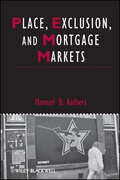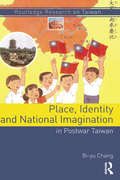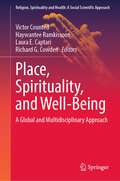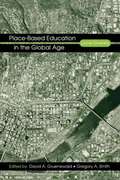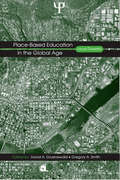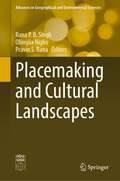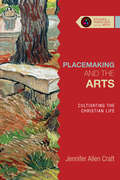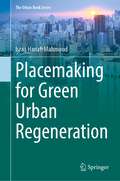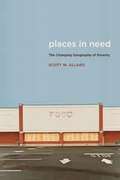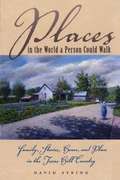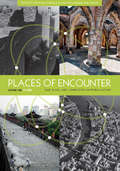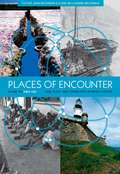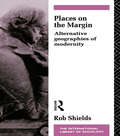- Table View
- List View
Place, Alterity, and Narration in a Taiwanese Catholic Village (Asian Christianity in the Diaspora)
by Marco LazzarottiThis book introduces a simple idea: when we tell a story, we tell a story and at the same time create the world where this story takes place. Narration creates environments, spaces and, in a certain sense, gives symbolic meanings and values to the identities by which people interact in their daily experiences. Set in the multicultural and multireligious Taiwanese environment, this book describes the interactions, and above all the narrations, linked to a Catholic village located in the Taiwanese countryside. Catholicism in Taiwan is a minor religion (around 2% of the population), and considered a foreign and heterodox religion, something different and "other" from the Taiwanese mainstream religious environment. It is this sense of alterity that creates the stories about this place and, as a consequence, creates this place and its special identity.
Place, Catholicism and Violence: The Construction of Place in Caracas’ Barrios
by Gabriela Quintana VigiolaThis book explores the interwoven nature of place, Catholicism and violence in Caracas’ barrios. Using interdisciplinary perspectives to investigate themes of urban space, meaning as a psychosocial construct, criminal violence, and religiosity as culture, this book uncovers the underlying complexities of turning spaces into places through the built form, activities in the urban space and the meanings associated with it. Fundamental elements in the construction of place are used to understand the ways in which barrio residents conceive and construct the physicality of the private, public and religious spaces; how residents use the physical spaces of the barrios; and the psychosocial meanings residents associate with the spaces and activities. Using rich qualitative data and a case study design, the book relies on audio-visual data and interviews with organisers, residents and key participants in Petare, the largest barrio conglomeration in Caracas and Venezuela. Qualitative thematic analysis of participants’ experiences of Catholicism, violence and, ultimately, the construction of place exposes a unique argument: that meaningful urban spaces are embedded with emotions, memories, relationships, experiences and meanings, which turn them into places.
Place, Exclusion and Mortgage Markets (IJURR Studies in Urban and Social Change Book Series #37)
by Manuel B. AalbersUtilizing research from the U.S., Italy, and the Netherlands, Place, Exclusion and Mortgage Markets presents an in depth examination of the practice of redlining and the broader implications of contemporary urban exclusion processes. Covers exclusion in mortgage markets in three different countries - the U.S., Italy, and the Netherlands Presents an interdisciplinary perspective to the practice of redlining Connects the literature on social exclusion and financial exclusion
Place, Identity, and National Imagination in Post-war Taiwan (Routledge Research on Taiwan Series)
by Bi-yu ChangIn the struggles for political and cultural hegemony that Taiwan has witnessed since the 1980s, the focal point in contesting narratives and the key battlefield in the political debates are primarily spatial and place-based. The major fault line appears to be a split between an imposed identity emphasizing cultural origin (China) and an emphasis on the recovery of place identity of ‘the local’ (Taiwan). Place, Identity and National Imagination in Postwar Taiwan explores the ever-present issue of identity in Taiwan from a spatial perspective, and focuses on the importance of, and the relationship between, state spatiality and identity formation. Taking postwar Taiwan as a case study, the book examines the ways in which the Kuomintang regime naturalized its political control, territorialized the island and created a nationalist geography. In so doing, it examines how, why and to what extent power is exercised through the place-making process and considers the relationship between official versions of ‘ROC geography’ and the islanders’ shifting perceptions of the ‘nation’. In turn, by addressing the relationship between the state and the imagined community, Bi-yu Chang establishes a dialogue between place and cultural identity to analyse the constant changing and shaping of Chinese and Taiwanese identity. With a diverse selection of case studies including cartographical development, geography education, territorial declaration and urban planning, this interdisciplinary book will have a broad appeal across Taiwan studies, geography, cultural studies, history and politics.
Place, Race, and Identity Formation: Autobiographical Intersections in a Curriculum Theorist's Daily Life (Studies in Curriculum Theory Series)
by Ed Douglas McKnightIn this work of curriculum theory, Ed Douglas McKnight addresses and explores the intersections between place (with specific discussion of Kincheloe’s and Pinar’s conceptualization of place and identity) and race (specifically Winthrop Jordan’s historical analysis of race as an Anglo-European construction that became the foundation of a white mythos). To that end, he employs a form of narrative construction called curriculum vitae (course of life)—a method of locating and delineating identity formation which addresses how theories of place, race and identity formation play out in a particular concrete life. By working through how place racializes identity and existence, the author engages in a long Southern tradition of storytelling, but in a way that turns it inside out. Instead of telling his own story as a means to romanticize the sins of the southern past, he tells a new story of growing up within the "white" discourse of the Deep South in the 1960s and 70s, tracking how his racial identity was created and how it has followed him through life. Significant in this narrative is how the discourse of whiteness and place continues to express itself even within the subject position of a curriculum theorist teaching in a large Deep South university. The book concludes with an elaboration on the challenges of engaging in the necessary anti-racist complicated conversation within education to begin to work through and cope with heavy racialized inheritances.
Place, Spirituality, and Well-Being: A Global and Multidisciplinary Approach (Religion, Spirituality and Health: A Social Scientific Approach #7)
by Haywantee Ramkissoon Victor Counted Richard G. Cowden Laura E. CaptariThis book synthesizes perspectives on how ‘place’ is deeply intertwined with our spirituality and well-being. Split into three sections, this book brings together contributions from global scholars across a range of disciplines to unravel how the personal, social, and cultural spheres of place shape our spiritual experiences and overall well-being. It is an essential read for those interested in enriching their knowledge of the linkages between place, spirituality, and well-being, while also providing a foundation for future research on place and its intersections with both spirituality and well-being.
Place- and Community-Based Education in Schools (Sociocultural, Political, and Historical Studies in Education)
by David Sobel Gregory A. SmithPlace- and community-based education – an approach to teaching and learning that starts with the local – addresses two critical gaps in the experience of many children now growing up in the United States: contact with the natural world and contact with community. It offers a way to extend young people’s attention beyond the classroom to the world as it actually is, and to engage them in the process of devising solutions to the social and environmental problems they will confront as adults. This approach can increase students’ engagement with learning and enhance their academic achievement. Envisioned as a primer and guide for educators and members of the public interested in incorporating the local into schools in their own communities, this book explains the purpose and nature of place- and community-based education and provides multiple examples of its practice. The detailed descriptions of learning experiences set both within and beyond the classroom will help readers begin the process of advocating for or incorporating local content and experiences into their schools.
Place- and Community-based Education in Schools
by David Sobel Gregory A. SmithPlace- and community-based education – an approach to teaching and learning that starts with the local – addresses two critical gaps in the experience of many children now growing up in the United States: contact with the natural world and contact with community. It offers a way to extend young people’s attention beyond the classroom to the world as it actually is, and to engage them in the process of devising solutions to the social and environmental problems they will confront as adults. This approach can increase students’ engagement with learning and enhance their academic achievement. Envisioned as a primer and guide for educators and members of the public interested in incorporating the local into schools in their own communities, this book explains the purpose and nature of place- and community-based education and provides multiple examples of its practice. The detailed descriptions of learning experiences set both within and beyond the classroom will help readers begin the process of advocating for or incorporating local content and experiences into their schools.
Place-Based Education in the Global Age: Local Diversity
by Gregory A. Smith David A. GruenewaldThe book is a collection of success stories from around the United States and explores some of the reasons for pursuing place-based education.It shows how educators from diverse places are using place as a focal point for developing community leaders, understanding the tensions between Israel and Palestine, and for showing future teachers the power of place-based learning.
Place-Based Education in the Global Age: Local Diversity
by Gregory A. Smith David A. Gruenewald"Polished, clear, insightful, and meaningful.... This volume amounts to nothing less than a complete rethinking of what progressive education can be at its best and how education can be reconceptualized as one of the central practices of a genuinely democratic and sustainable society.... It is the kind of book that has the potential to be transformative." Stephen Preskill, University of New Mexico "The editors and contributors are pioneers in the field of educational theory, policy, and philosophy.... They are opening new areas of inquiry and educational reform in ways that promise to make this book in very short time into a classic.... The practical applications and experiments included reveal the richness of grassroots initiatives already underway to bring educational theory and policy down to earth. While spanning the richest and deepest intellectual ideas and concepts, the stories told are the types that practitioners and teachers will be able to relate to in their daily undertakings." Madhu Suri Prakash, The Pennsylvania State University This volume – a landmark contribution to the burgeoning theory and practice of place-based education – enriches the field in three ways: First, it frames place-based pedagogy not just as an alternative teaching methodology or novel approach to environmental education but as part of a broader social movement known as the "Anew localism", which aims toward reclaiming the significance of the local in the global age. Second, it links the development of ecological awareness and stewardship to concerns about equity and cultural diversity. Third, it presents examples of place-based education in action. The relationship between the new localism and place-based education is clarified and the process of making connections between learners and their wider communities is demonstrated. The book is organized around three themes: Reclaiming Broader Meanings of Education; Models for Place-Based Learning; and Global Visions of the Local in Higher Education This is a powerfully relevant volume for researchers, teacher educators, and students across the fields of curriculum theory, educational foundations, critical pedagogy, multicultural education, and environmental education.
Placemaking Fundamentals for the Built Environment
by Dominique Hes Cristina Hernandez-SantinThis book is for all those actively working in the built environment. It presents the latest theory and practice of engaging with stakeholders to co-design, develop and manage thriving places. It starts from the importance of integrating design of nature into practice built on a foundation of First Nations understanding of place. The art of engagement of community, government and the development industry is discussed with reference to case studies and best practice techniques. The book then focuses on the critical role placemaking has in supporting resilience and adaptability of communities and looks at issues of leadership and governance. Building on these steps for placemaking, the last parts of the book address economics, evaluation, digital and art based tools and approaches to support projects that aim to create an engaged, contributive, collaborative and active citizen.
Placemaking and Cultural Landscapes (Advances in Geographical and Environmental Sciences)
by Pravin S. Rana Olimpia Niglio Rana P. B. SinghPlacemaking and cultural landscapes are worldwide multidisciplinary global concerns that cover many points of view of the common impacts of socio-economic cultural and rights jurisprudence planning, wellbeing and related advancements. Concerned with the complex interactions between the development and environment of those factors, it is important to seek ways, paths and implications for framing sustainability in all social activities. This book is mostly based on the 10th ACLA – Asian Cultural Landscape Association International Webinar Symposium that took place during September 26–27, 2020, in the Banaras Hindu University, Varanasi, India. It examines contemporary social–cultural issues in the context of the United Nations Sustainable Development Goals (UN-SDGs) and associated cultural and sacred landscapes. There, the emphasis is on awakening deeper cultural sensitivity in harmonizing the world and the role of society and spiritual systems, drawing upon multi-disciplinary and cross-cultural interfaces—all within the scope of the future of the earth. The book’s chapters add a new dimension of cultural understanding in the broad domain of emerging human geoscience, considered as key policy science for contributing towards sustainability and survivability science together with future earth initiatives.
Placemaking and the Arts: Cultivating the Christian Life (Studies in Theology and the Arts)
by Jennifer Allen CraftWe are, each one of us, situated in a particular place.
Placemaking for Green Urban Regeneration (The Urban Book Series)
by Israa Hanafi MahmoudThis book investigates the dynamics and the role of green urban regeneration using nature-based solutions (NBS) in contributing to the cultural aspects of public spaces. In the first part of the book, insights on analytical methods, planning strategies and shared governance examples are given, as well as, an assessment tool, namely public space index (PSI), is given for successfully measuring sociability impact while using a placemaking approach to green urban regeneration processes. In the second part, the case study (Rose Kennedy Greenway of Boston, MA, USA) has been extensively researched during many years of observations and analysis which gives a realistic taste of the implementation of the proposed PSI. The book’s last part reflects on PSI to measure its adaptability and replicability in other contexts, whereas NBS are playing a major role in physical and spatial green urban regeneration in current cities contexts’.
Places That Matter: Knowing Your Neighborhood through Data
by Dr Joan FerrantePlaces that Matter asks the reader to identify a place that matters in their life—their home, a place of worship, a park, or some other site that acts as an emotional and physical anchor and connects them to a neighborhood. Then readers are asked: In what ways do I currently support—or fail to support—that neighborhood? Should support be increased? If so, in what ways? Joan Ferrante guides students through a learning experience that engages qualitative and quantitative research and culminates in writing a meaningful plan of action or research brief. Students are introduced to basic concepts of research and are exposed to the experiences of gathering and drawing on data related to something immediate and personal. The class-tested exercises are perfect for courses that emphasize action-based research and social responsibility. The book’s overarching goal is to help students assess their neighborhood’s needs and strengths and then create a concrete plan that supports that neighborhood and promotes its prosperity. Accompanying the book is a facilitator’s companion website to guide action-based research experiences, which includes rubrics that are aligned to common learning objectives and are also designed to make tracking and reporting easier.
Places in My Community (Into Reading, Read Aloud #Module 3, Book 1)
by Bobbie KalmanNIMAC-sourced textbook
Places in Need: The Changing Geography of Poverty
by Scott W. AllardAmericans think of suburbs as prosperous areas that are relatively free from poverty and unemployment. Yet, today more poor people live in the suburbs than in cities themselves. In Places in Need, social policy expert Scott W. Allard tracks how the number of poor people living in suburbs has more than doubled over the last 25 years, with little attention from either academics or policymakers. Rising suburban poverty has not coincided with a decrease in urban poverty, meaning that solutions for reducing poverty must work in both cities and suburbs. Allard notes that because the suburban social safety net is less-developed than the urban safety net, a better understanding of suburban communities is critical for understanding and alleviating poverty in metropolitan areas. Using census data, administrative data from safety net programs, and interviews with nonprofit leaders in the Chicago, Los Angeles, and Washington, D.C. metropolitan areas, Allard shows that poor suburban households resemble their urban counterparts in terms of labor force participation, family structure, and educational attainment. In the last few decades, suburbs have seen increases in single-parent households, decreases in the number of college graduates, and higher unemployment rates. As a result, suburban demand for safety net assistance has increased. Concerning is evidence suburban social service providers—which serve clients spread out over large geographical areas, and often lack the political and philanthropic support that urban nonprofit organizations can command—do not have sufficient resources to meet the demand. To strengthen local safety nets, Allard argues for expanding funding and eligibility to federal programs such as SNAP and the Earned Income Tax Credit, which have proven effective in urban and suburban communities alike. He also proposes to increase the capabilities of community-based service providers through a mix of new funding and capacity-building efforts. Places in Need demonstrates why researchers, policymakers, and nonprofit leaders should focus more on the shared fate of poor urban and suburban communities. This account of suburban vulnerability amidst persistent urban poverty provides a valuable foundation for developing more effective antipoverty strategies.
Places in the World a Person Could Walk: Family, Stories, Home, and Place in the Texas Hill Country
by David SyringSpring-fed creeks. Old stone houses. Cedar brakes and bleached limestone. The Hill Country holds powerful sway over the imagination of Texans. So many of us dream of having our own little place in the limestone hills. The Hill Country feels just like home, even if you've never lived there. <p><p> This beautifully written book explores what the Hill Country has meant as a homeplace to the author, his family, and longtime residents of the area, as well as to newcomers. David Syring listens to the stories that his aunts, uncles, and cousins tell about life in the Hill Country and grapples with their meaning for his own search for a place to belong. He also collects short stories focused around Honey Creek Church to consider how places become containers for memory. And he draws upon several years of living in Fredericksburg to talk about the problems and opportunities created by heritage tourism and the development of the town as a "home" for German Americans. These interconnected stories illuminate what it means to belong to a place and why the Texas Hill Country has become the spiritual, if not actual, home of many people.
Places of Encounter
by Aran Mackinnon Elaine MackinnonPlaces of Encounter provides a place-based approach to world history, focusing on specific locations at critical moments when human history was transformed as a result of encounters--physical, political, cultural, intellectual, and religious. Original, contributed essays by leading academics in the field explore places from Hadar to Xi’an, Salvador to New York, and numerous other locations that have produced historical shockwaves and significant global impact throughout history. With a chronologically organized table of contents, each chapter dissects a particular moment in history, with personal commentary from each contributor, a narrative of the location’s historical significance at the time, and a section on significant global connections. Primary sources and discussion questions at the end of each chapter allow students a view into the lives of individuals of the time. Students will experience the narrative of historic individuals as well as modern scholars looking back over documentation to offer their own views of the past, providing students with the perfect opportunity to see how scholars form their own views about history. This text can be purchased as two volumes, providing a breadth of information for survey courses in world history.
Places of Encounter: Volume II
by Aran Mackinnon Elaine MackinnonPlaces of Encounter provides a place-based approach to world history, focusing on specific locations at critical moments when human history was transformed as a result of encounters--physical, political, cultural, intellectual, and religious. Original, contributed essays by leading academics in the field explore places from Hadar to Xi’an, Salvador to New York, and numerous other locations that have produced historical shockwaves and significant global impact throughout history. With a chronologically organized table of contents, each chapter dissects a particular moment in history, with personal commentary from each contributor, a narrative of the location’s historical significance at the time, and a section on significant global connections. Primary sources and discussion questions at the end of each chapter allow students a view into the lives of individuals of the time. Students will experience the narrative of historic individuals as well as modern scholars looking back over documentation to offer their own views of the past, providing students with the perfect opportunity to see how scholars form their own views about history. This text can be purchased as two volumes, providing a breadth of information for survey courses in world history.
Places of Memory and Legacies in an Age of Insecurities and Globalization (Key Challenges in Geography)
by Gerry O’ReillyIn this book, practitioners and students discover perspectives on landscape, place, heritage, memory, emotions and geopolitics intertwined in evolving citizenship and democratization debates. This volume shows how memorialization can contribute to wider inclusive interpretations of history, tourism and human rights promoted by the European Project. It's geographies of memories can foster cooperation as witnessed throughout Europe during the 2014-18 WWI commemorations. Due to new world orders, geopolitical reconfigurations and ideals that emerged after 1918, many countries ranging from the Baltic and Russia to the Balkans, Turkey and Greece, eastern and central Europe to Ireland are continuing with commemorations regarding their specific memories in the wider Europe. Shared memorial spaces can act in post conflict areas as sites of reconciliation; nonetheless `the peace' cannot be taken for granted with insecurities, globalization, and nationalisms in the USA and Russia; the UK's Brexit stress and populist movements in Western Europe, Visegrád and Balkan countries. Citizen-fatigue is reflected in socio-political malaise mirrored in France's Yellow Vest movement and elsewhere. Empathy with other peoples' places of memory can assist citizens learn from the past. Memory sites promoted by the EU, Council of Europe and UNESCO may tend to homogenize local memories; nevertheless, they act as vectors in memorialization, stimulating debate and re-evaluating narratives. This textbook combines geographical, inter-cultural and inter-disciplinary approaches and perspectives on spaces of memory by a range of authors from different countries and traditions offers the reader diverse and holistic perspectives on cultural geography, dynamic geopolitics, globalization and citizenship.
Places of Memory: Whiteman's Schools and Native American Communities (Sociocultural, Political, and Historical Studies in Education)
by Alan PeshkinWhile visiting New Mexico, the author was struck with the opportunity the state presents to explore the school-community relationship in rural, religious, and multiethnic sociocultural settings. In New Mexico, the school-community relationship can be learned within four major culture groups -- Indian, Spanish-American, Mexican, and Anglo. Together, studies of these culture groups form a portrait of schooling in New Mexico, further documenting the range of ways that host communities in our educationally decentralized society use the prerogatives of local control to "create" schools that fit local cultural inclinations. The first of four planned volumes, this book studies the Pueblo Indians and Indian High School. The school is a nonpublic, state-accredited, off-reservation boarding school for more than 400 Indian students. A large majority of the students are from Pueblo tribes, while others are from Navajo and Apache tribes. As a state-accredited school, it subscribes to curricular, safety, and other requirements of New Mexico. As a nonpublic school devoted to Indian students, it has the prerogative to be as distinctive as the ethnic group it serves. USE SHORT BLURB COPY FOR CATALOGS: This ethnography of the Pueblo Indians and Indian High School epxlores some of the ways that host communities in our decentralized society use the perogatives of local consul to create schools that fit local cultural inclinations.
Places of Tenderness and Heat: The Queer Milieu of Fin-de-Siècle St. Petersburg
by Olga PetriPlaces of Tenderness and Heat is a ground-level exploration of queer St. Petersburg at the fin-de-siècle. Olga Petri takes us through busy shopping arcades, bathhouses, and public urinals to show how queer men routinely met and socialized. She reconstructs the milieu that enabled them to navigate a city full of risk and opportunity.Focusing on a non-Western, unexplored, and fragile form of urban modernity, Petri reconstructs a broad picture of queer sociability. In addition to drawing on explicitly recorded incidents that led to prosecution or medical treatment, she investigates the many encounters that escaped bureaucratic surveillance and suppression. Her work reveals how queer men's lives were conditioned by developing urban infrastructure, weather, light and lighting, and the informal constraints on enforcing law and moral order in the city's public spaces. Places of Tenderness and Heat is an ambitious record of the dynamic negotiation of illicit male homosexual sex, friendship, and cruising and uncovers a historically fascinating urban milieu in which efforts to manage the moral landscape often unintentionally facilitated queer encounters.
Places of Traumatic Memory: A Global Context (Palgrave Macmillan Memory Studies)
by Annie Pohlman Amy L. Hubbell Natsuko Akagawa Sol Rojas-LizanaThis volume explores the relationship between place, traumatic memory, and narrative. Drawing on cases from Africa, Asia, Europe, Oceania, and North and South America, the book provides a uniquely cross-cultural and global approach. Covering a wide range of cultural and linguistic contexts, the volume is divided into three parts: memorial spaces, sites of trauma, and traumatic representations. The contributions explore how acknowledgement of past suffering is key to the complex inter-relationship between the politics of memory, expressions of victimhood, and collective memory. Contributors take note of differing aspects of memorial culture, such as those embedded in war memorials, mass grave sites, and exhibitions, as well as journalistic, literary and visual forms of commemorations, to investigate how narratives of memory can give meaning and form to places of trauma.
Places on the Margin: Alternative Geographies of Modernity (International Library of Sociology)
by Rob ShieldsThe debate on modernity and postmodernity has awakened interest in the importance of the spatial for cultural formations. But what of those spaces that exist as much in the imagination as in physical reality? This book attempts to develop an alternative geography and sociology of space by examining `places on the margin'.


